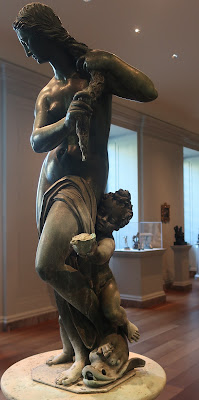The Last Duel (2021) directed by Ridley Scott
Former friends Jean (Matt Damon) and Jacques (Adam Driver) are locked in the titular battle during the movie's opening. The story then moves back in time to explain how they wound up in the last publicly-sanctioned (i.e. royally-approved) duel to prove the innocence of someone. Since it's the mid-1300s, France is at war with England and most able-bodied men are fighting. Jean is called a squire though he leads several battles, most failures. He returns home where his wife and son have died of plague. His father is captain of a keep. He looks forward to taking on the constabulary responsibilities when his father passes on but is concerned about his lack of an heir and his status with the hierarchy. The local lord (Ben Affleck) finds Jean annoying and has no interest in supporting him since Jean is a failure in many ways. Jacques has the ear of the local lord (they do a lot of carousing together) and occasionally puts in a good word. Jean does not help on that front when he marries Marguerite (Jodie Comer), the daughter of a disgraced, but wealthy, knight. She is charming and well-educated, catching the attention of the Don-Juanish Jacques. The male friendship falls apart as Jacques becomes the rent collector for the lord, forcing Jean to look for money to pay debts. He goes off to war, leaving his wife behind with his unsympathetic mother. The mother takes all the servants one day to run errands, the day that Jacques comes to declare his love. That declaration turns into rape, which brings the friends into court and then the battlefield to determine whether Marguerite was really raped or not.
The movie uses a Rashomon-style narrative, relating events first from Jean's perspective, then Jacques', then Marguerite's. Each telling has different details and nuances that are clearly from the prejudices and attitudes of each character. The beginning and the ending, i.e. the duel, is an objective framing device, with the typical end credits describing how the lives of the surviving characters turned out. Watching the actors perform variations of the characters based on the perspectives of other characters is interesting. But not enough to carry the movie, which has several flaws.
First, the filmmakers blow the Rashomon-style by clearly flagging up one of the narratives as "The Truth," cutting the dramatic tension and intellectual enjoyment. Another problem is that the "Truth" character seems least likely to have actually lived in the late Middle Ages (though the way the film is produced, they clearly think of the time as the Dark Ages). Most of the characters come off more like modern people except for minor characters like doctors (who are all about "bodily humors" and astrological assessments) and priests (who are more about male patriarchy than divinity). Scott's other medieval films (Robin Hood and Kingdom of Heaven) have very similar problems. The performances are entertaining but the overall plot and visual style leave a lot to be desired.
Not recommended--this is another "based on true events" hatchet-job on the Middle Ages by Ridley Scott.























































